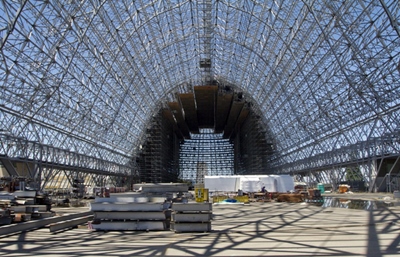 MOUNTAIN VIEW — The federal government is in the final stages of collecting proposals for a restoration of the iconic Hangar One at Moffett Federal Airfield and new development on a portion of the aviation facility, a project that’s likely to become a new landmark in the region.
MOUNTAIN VIEW — The federal government is in the final stages of collecting proposals for a restoration of the iconic Hangar One at Moffett Federal Airfield and new development on a portion of the aviation facility, a project that’s likely to become a new landmark in the region.
In addition to the upgrades of the giant hangar, the winning bidder will operate, manage and maintain the 1,056-acre airfield, according to the government’s request for proposals for the project. The winning bidder would be able to develop commercial buildings such as offices or research facilities on 100 acres of the site, and possibly on the golf course.
But off-limits for development is the 124-acre Shenandoah Historic District, which includes Hangars One, Two and Three along with other buildings. Plus, developers would have to work around restrictions concerning existing runways and future flight operations and buffer zones necessary for aviation.
NASA, the nation’s space agency, which wields ultimate authority over the site, will require the winning bidder on the project to sign a long-term lease for the land, and to renovate and refurbish the skin of the mammoth 350,000-square-foot Hangar One.
The 100 acres available for development are spread across three locations at the airfield. It’s also possible that development could occur inside Hangar One.
Originally, the bidding process was to have been completed by Oct. 16. The partial shutdown of the federal government has prompted the government to delay the final date for submittal of bids, and the updated timetable has not been announced.
“That’s a sizable chunk of land and it really opens up the opportunities of what you could do out there,” said Scott Anderson, chief economist of Bank of the West.
Offices, retail, housing, advanced research facilities, incubator buildings, parks, educational centers, or a combination of these are among the possibilities for new development.
The General Services Administration is overseeing the selection of a developer for the airfield, and the GSA’s acting administrator said the competitive bidding process was “designed to create opportunities for development while eliminating NASA’s management costs of the airfield.”
“In the face of declining budgets and significant mission changes, NASA has been challenged to re-purpose historic Hangar One and manage the airfield to support other non-NASA users,” GSA Acting Administrator Dan Tangherlini said in the statement,
The bids are secret but several groups are eyeing the complex for redevelopment, said sources familiar with the bidding process.
Expected bidders include Google (GOOG) executives, who want to park their private planes in a restored Hangar One; two groups promoting a private sector space industry, and the Air and Space West Foundation, which is eyeing a museum in Hangar One. The site is adjacent to the NASA Ames Research Center, for decades a vital cog in the nation’s space program.
“For whatever is built out there, this is a very desirable area,” said Chad Leiker, a vice president with Kidder Mathews, a commercial real estate firm. “Companies really want to get into that part of Santa Clara County.”
The property is a short distance from the headquarters of major tech companies, including Mountain View-based Google, and new occupants of the site could include some fast-expanding tech companies.
Google and several other possible bidders declined to confirm or deny their interest in the site.
However, former NASA scientist Sean Casey, co-founder of Silicon Valley Space Center, said his group intends to bid on the project, hoping it will help position Santa Clara County and the nation for development of a private sector space industry.
“We want to launch entrepreneurs in the new space industry,” Casey said. “Rather than look towards the past, or trying to imagine the future, we want to create the future.”
Other states, including Texas and Florida, are attempting to position themselves to capitalize on the future of a private sector space industry, and Casey says California needs to be competitive.
“Silicon Valley needs to be a home for the new space industry,” he said.
Casey’s group wants to develop office space for pioneers in the new industry with expertise in small satellites, space communications, mission design, unmanned aerial systems, robotics, 3-D printing, aeronautics, and astronomy.
Rob Enderle, a San Jose-based analyst who tracks the technology sector, says Moffett could become “a showcase for Silicon Valley.”
“You could have research into alternative energy, or testing on self-driving cars, or other automobiles of the future,” he said.
Federal officials have made clear that any redevelopment would have to include a restoration of the iconic Hangar One, whose renovation would likely have a price tag of $33 million or more.
Other obstacles have recently surfaced. The U.S. Environmental Protection Agency, in a Sept. 26 letter to NASA Ames officials, complained that the EPA wasn’t provided with a chance to comment about the proposal.
“Several omissions and inaccuracies” are contained in the NASA and GSA request for proposals about the redevelopment efforts, John Chesnutt, chief of the federal facility section of the EPA’s Superfund Division, wrote in a letter to NASA officials. The EPA concerns include wanting assurance that the renovation of Hangar One does not release hazardous materials during the work.
Chesnutt said NASA must certify that the site is suitable for lease and that “the uses contemplated for the lease are consistent with protection of human health and the environment.” It isn’t yet clear what effect the EPA objections will have on the project.
“Whatever is built there, make it a forward-looking facility,” Enderle said. “It would bring people in and let them know what Silicon Valley is all about.”
